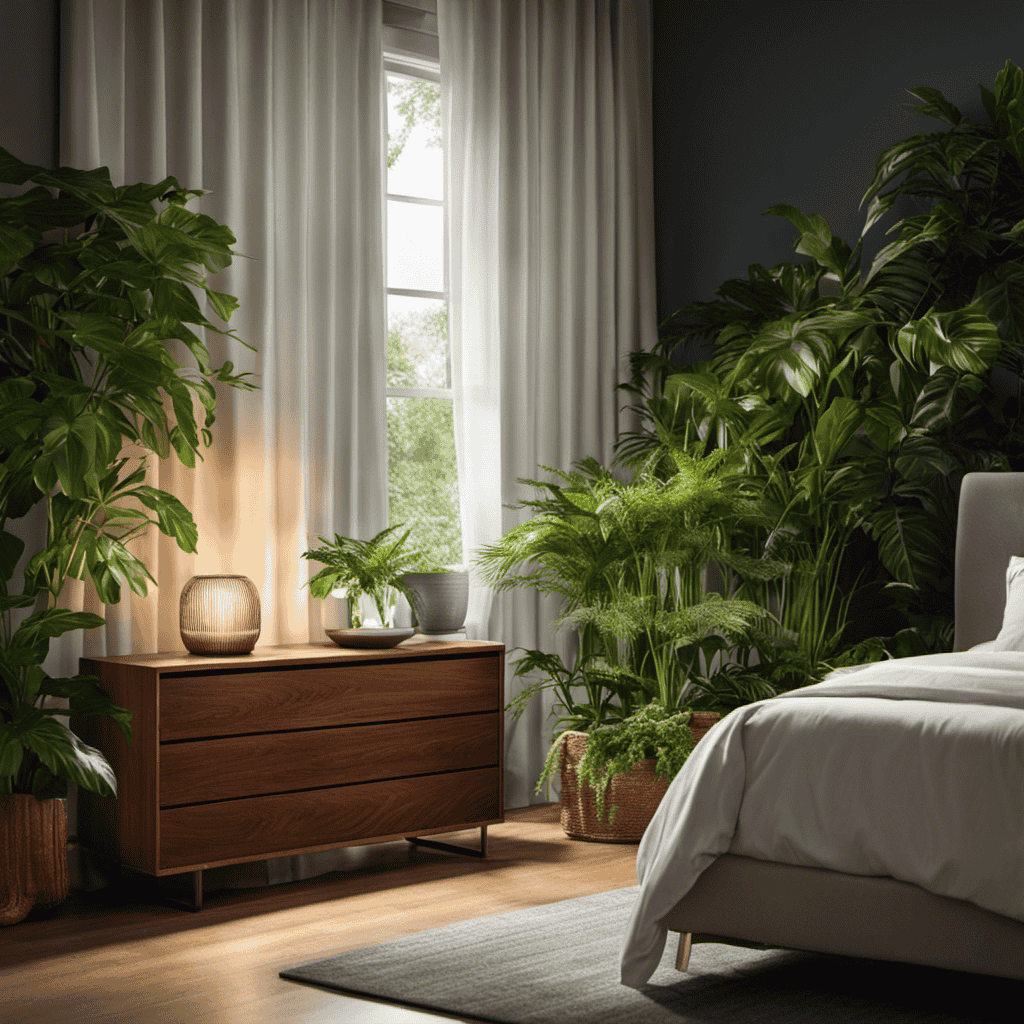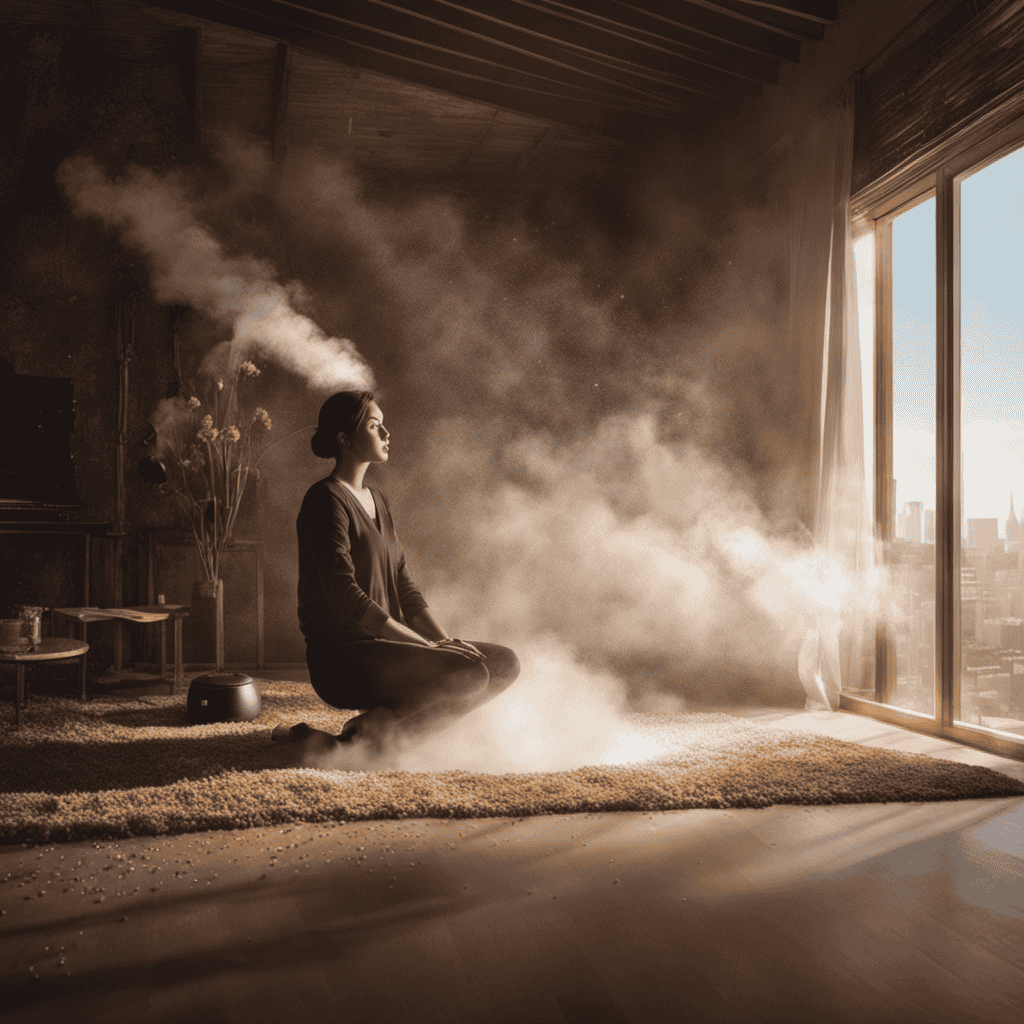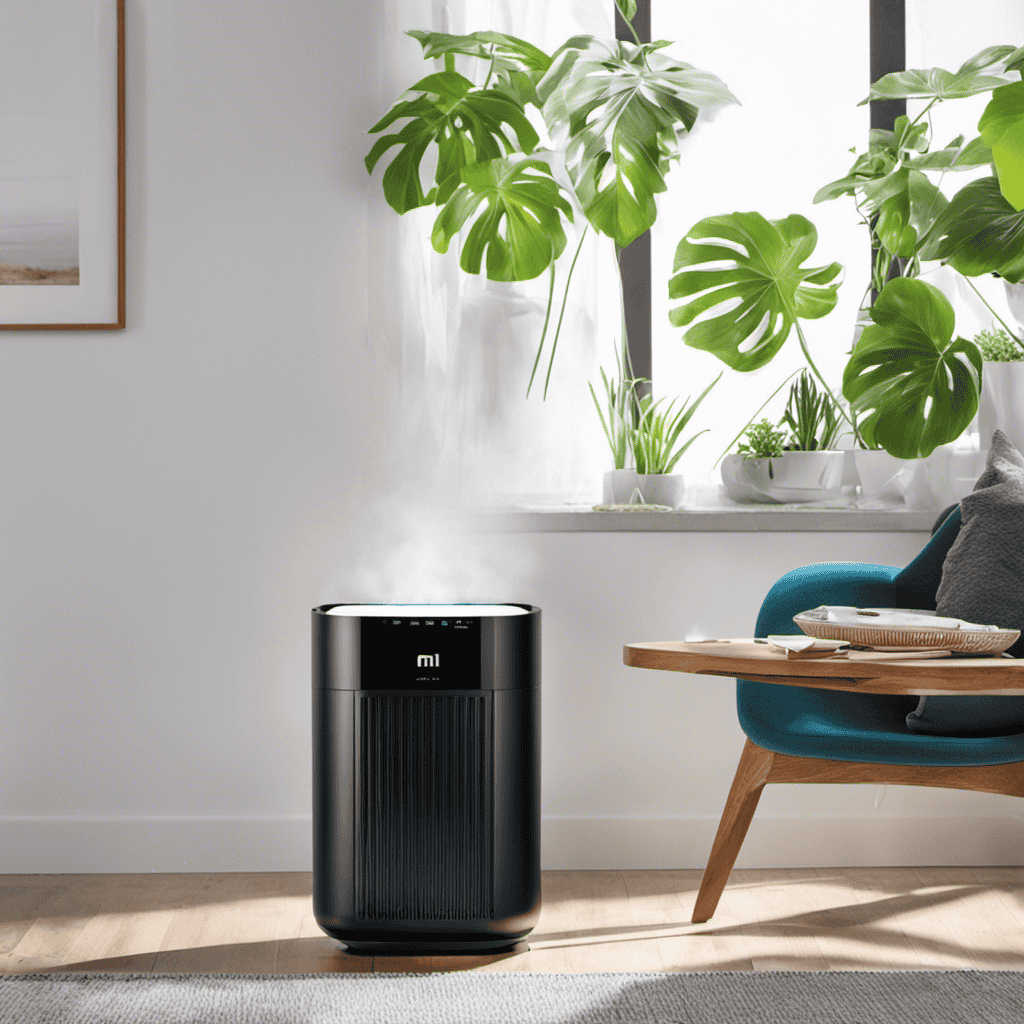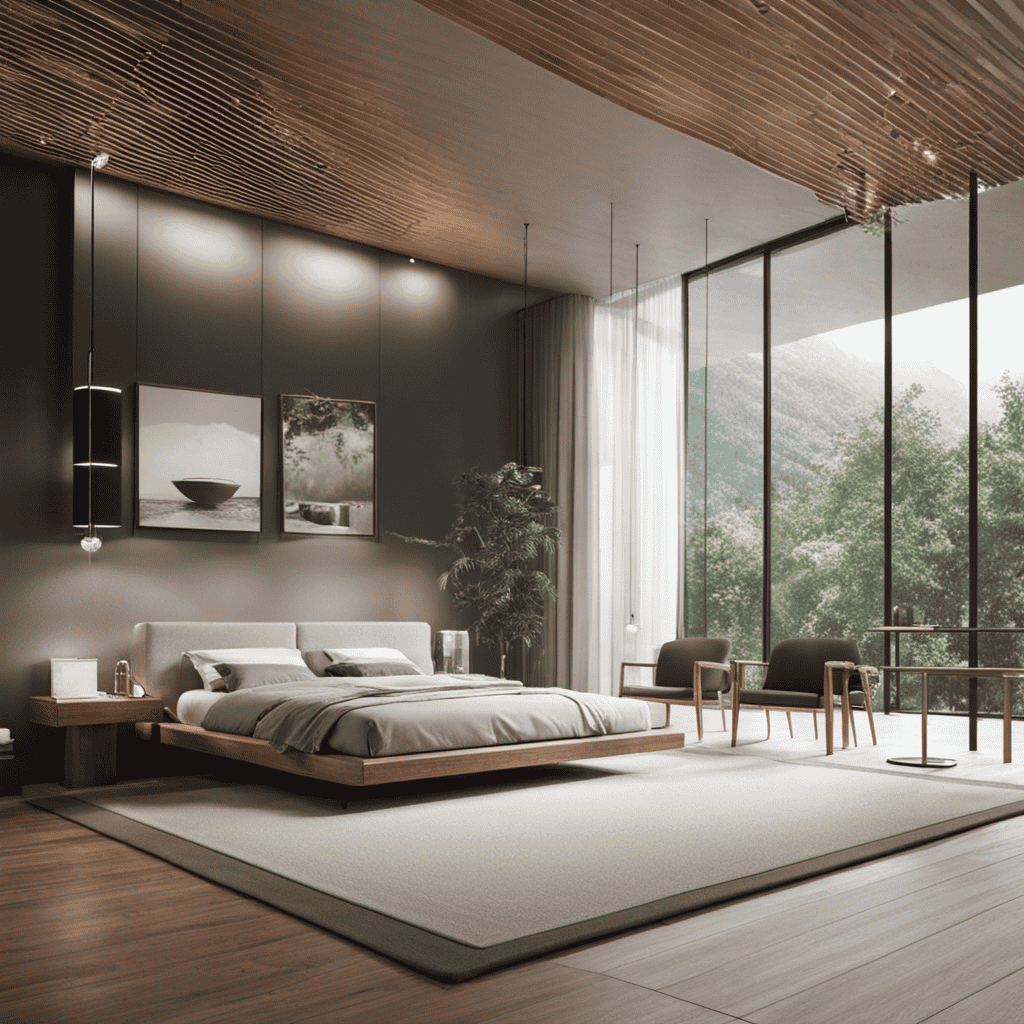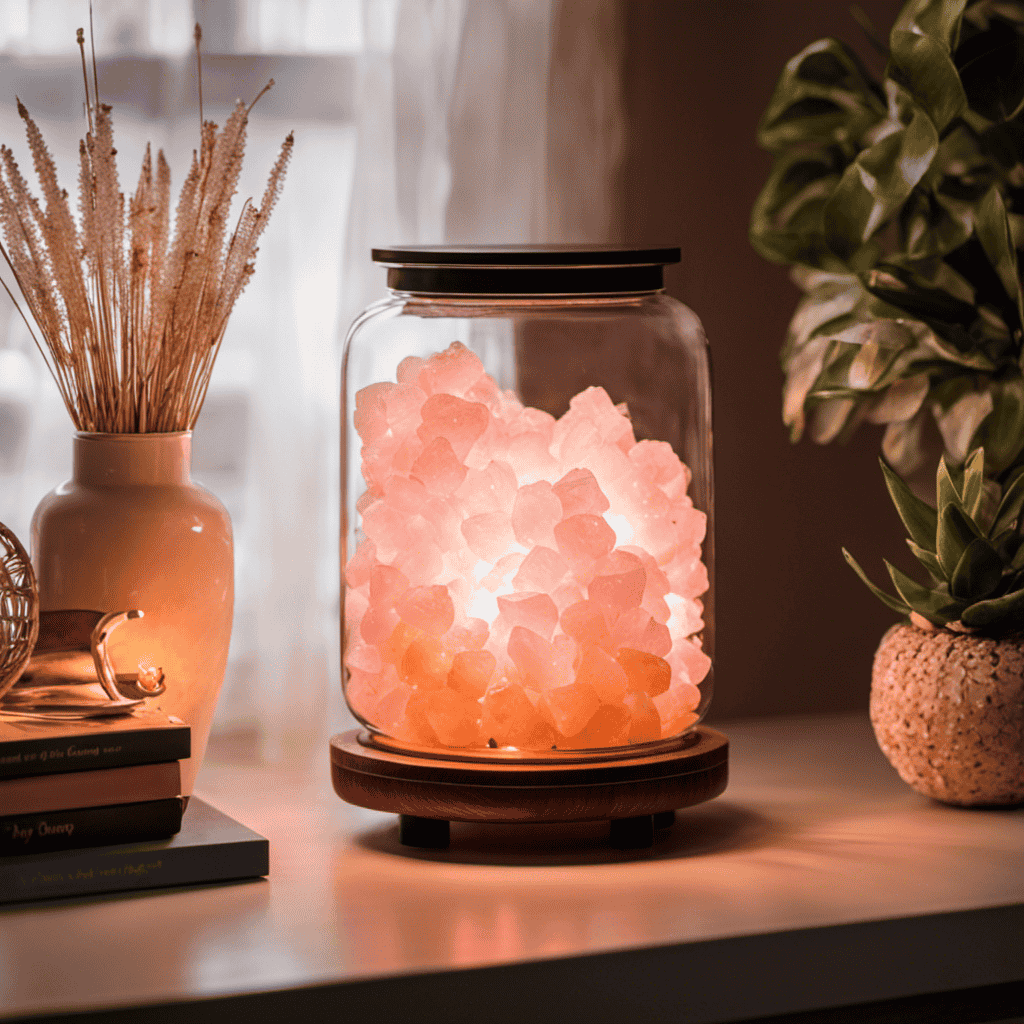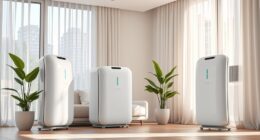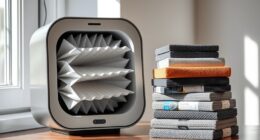Are you aware that indoor air can be up to five times more polluted than outdoor air? This is why it’s crucial to learn how to properly utilize a HEPA air purifier.
In this article, I will guide you through the process of selecting the right HEPA air purifier, placing it properly, operating and adjusting the settings, and maintaining and cleaning it to ensure maximum efficiency.
Get ready to breathe clean and fresh air with your HEPA air purifier!
Key Takeaways
- HEPA technology removes particles as small as 0.3 microns from the air.
- HEPA filters capture dust, pollen, pet dander, and bacteria.
- Proper placement and effective filter placement ensure proper filtration.
- Adjusting the fan speed and utilizing the timer function can enhance air circulation and filtration efficiency.
Understanding HEPA Technology
HEPA technology is essential for removing particles as small as 0.3 microns from the air. The benefits of HEPA technology are numerous.
HEPA filters are designed to capture and trap tiny particles such as dust, pollen, pet dander, and even bacteria. The filters consist of a dense mat of fibers that create a maze-like structure. As air passes through the filter, the particles become trapped, allowing only clean air to pass through. This technology is highly effective in improving indoor air quality and reducing allergens in the environment.
HEPA filters are also long-lasting and require minimal maintenance. Understanding how HEPA filters work is crucial in selecting the right HEPA air purifier for your needs.
Now that we have covered the basics of HEPA technology, let’s move on to selecting the right HEPA air purifier.
Selecting the Right HEPA Air Purifier
When choosing the right air purifier, it’s important to consider factors such as size, filtration rate, and noise level. Size refers to the coverage area of the purifier, ensuring it can effectively clean the air in your desired space. The filtration rate determines how efficiently the purifier removes airborne particles. One of the most effective types of filters is the HEPA filter, which stands for High Efficiency Particulate Air. HEPA filters can capture up to 99.97% of particles as small as 0.3 microns, making them ideal for removing allergens, dust, and pollutants from the air. Additionally, HEPA filters are easy to maintain, typically requiring replacement every 6 to 12 months. By using a HEPA air purifier, you can enjoy the benefits of cleaner, healthier air in your home or office.
| Size | Filtration Rate | Noise Level |
|---|---|---|
| Small | High | Low |
| Medium | Medium | Medium |
| Large | Low | High |
| Extra Large | Ultra High | Very Low |
| Customizable | Variable | Adjustable |
Proper Placement of the HEPA Air Purifier
When it comes to getting the most out of your HEPA air purifier, optimal purifier positioning and effective filter placement are key factors to consider.
Proper placement of the purifier ensures that the air is being efficiently circulated and purified throughout the room.
Additionally, placing the filters in strategic locations within the purifier maximizes their effectiveness in capturing and removing airborne contaminants.
Optimal Purifier Positioning
To maximize effectiveness, it’s important to place your air purifier in an area with proper airflow. Here are some key factors to consider for optimal purifier positioning:
- Distance from walls: Keep a distance of at least 12 inches from walls to ensure unrestricted airflow.
- Height placement: Place the purifier at a height where it can effectively capture airborne pollutants.
- Central location: Position the purifier in the center of the room to allow for better air circulation.
- Avoid obstructions: Ensure that there are no furniture or objects blocking the intake and outlet vents of the purifier.
- Away from direct sunlight: Avoid placing the purifier in direct sunlight as it may affect its performance.
By following these guidelines, you can ensure that your air purifier is placed in an area that promotes efficient air circulation and minimizes the need for frequent filter replacements.
Now, let’s move on to the next section about effective filter placement.
Effective Filter Placement
Properly positioning your air purifier’s filter is crucial for optimal performance. When it comes to filter maintenance, the placement of the filter plays a significant role in purifier efficiency. To ensure effective filter placement, it is important to follow the manufacturer’s instructions.
Typically, the filter should be placed in a designated slot or compartment within the air purifier. This ensures that the air is properly filtered as it passes through the unit.
Additionally, regularly checking and cleaning the filter is essential for maintaining its efficiency. Dust and debris can accumulate on the filter, hindering its ability to effectively capture airborne particles.
By maintaining clean and properly placed filters, you can maximize the performance of your air purifier and ensure that it operates at its best.
Now, let’s move on to the next section about operating and adjusting the HEPA air purifier settings.
Operating and Adjusting the HEPA Air Purifier Settings
When it comes to operating and adjusting the settings of your HEPA air purifier, there are a few key points to consider.
First, finding the optimal purification settings is crucial for maximizing the effectiveness of the device.
Additionally, controlling the noise level of the purifier is important for maintaining a peaceful environment.
Lastly, regular filter maintenance is essential for keeping your air purifier in top condition and ensuring its longevity.
Optimal Purification Settings
For the best results, it’s important to adjust the purification settings on your HEPA air purifier. By optimizing these settings, you can ensure optimal performance and extend the lifespan of your filters. Here are five key points to consider:
-
Adjust the fan speed: By increasing the fan speed, you can enhance the air circulation and filtration efficiency. However, keep in mind that higher fan speeds may result in increased noise levels.
-
Set the timer: Utilize the timer function to control the operating hours of your purifier. This can help conserve energy and prolong the filter lifespan.
-
Monitor the air quality: Many HEPA air purifiers come with built-in sensors that can detect the air quality. Use this feature to automatically adjust the purification settings based on the pollution levels in your environment.
-
Regularly clean or replace filters: Follow the manufacturer’s guidelines to clean or replace filters at the recommended intervals. This ensures efficient filtration and maintains the purifier’s performance.
-
Consider the room size: Different models of HEPA air purifiers are designed to cater to specific room sizes. Select a purifier that matches the square footage of your room for optimal purification.
Noise Level Control
By adjusting the fan speed on your HEPA air purifier, you can reduce noise levels while still maintaining efficient air circulation and filtration. Noise reduction is an important factor to consider, especially if you plan to use the air purifier in your bedroom or office where quiet operation is desired.
Most HEPA air purifiers come with multiple fan speed settings, allowing you to customize the noise level according to your preference. Lower fan speeds tend to produce less noise, but they may also reduce the air purifier’s overall performance. It is recommended to start with the lowest fan speed and gradually increase it until you find a balance between noise reduction and efficient air purification. This way, you can enjoy a quiet and peaceful environment while still benefiting from clean and fresh air.
Now, let’s move on to some filter maintenance tips to ensure the longevity and effectiveness of your HEPA air purifier.
Filter Maintenance Tips
Now that we’ve discussed how to control the noise level of a HEPA air purifier, let’s move on to the important topic of filter maintenance. Proper filter maintenance is crucial for the optimal performance of your air purifier and to ensure the cleanest air possible in your home.
Here are some tips to help you maintain your filters and extend their lifespan:
- Regularly clean the pre-filter to remove larger particles and debris.
- Follow the manufacturer’s instructions for proper filter replacement.
- Vacuum or gently brush the HEPA filter to remove accumulated dust and particles.
- Consider using a filter replacement indicator to know when it’s time to change the filters.
- Avoid placing the air purifier in areas with excessive smoke or strong odors to prevent premature filter clogging.
Maintaining and Cleaning the HEPA Air Purifier
To keep your HEPA air purifier running efficiently, make sure to regularly clean the filters and replace them as needed. Cleaning the filters is essential to remove dirt, dust, and other pollutants that accumulate over time. The recommended cleaning schedule for HEPA air purifier filters depends on the manufacturer’s instructions, but generally, it is advisable to clean them every 2-3 months. However, if you live in a highly polluted area or have pets, you may need to clean them more frequently. When cleaning the filters, follow these techniques: gently vacuum the surface to remove larger particles, rinse with water to remove trapped particles, and let them air dry completely before reinstalling. Remember to replace the filters when they become visibly dirty or when the air purifier’s performance declines.
| Cleaning Technique | Recommended Cleaning Schedule |
|---|---|
| Vacuuming | Every 2-3 months |
| Rinsing | Every 2-3 months |
| Air Drying | Every 2-3 months |
| Replacement | When visibly dirty or as needed |
Regular maintenance and cleaning of your HEPA air purifier’s filters will ensure that it continues to provide clean and fresh air for you and your family.
Tips for Maximizing the Efficiency of Your HEPA Air Purifier
For maximum efficiency, make sure you place the HEPA air purifier in a central location in the room where it can circulate air effectively. This will ensure that the purifier can capture and filter the maximum amount of airborne particles, improving indoor air quality.
Here are some tips to maximize the efficiency of your HEPA air purifier:
- Clean or replace the HEPA filter regularly to maintain its effectiveness.
- Keep the surrounding area clean and free from dust and debris.
- Avoid blocking the air intake or exhaust vents of the purifier.
- Run the air purifier continuously or for extended periods of time to continuously clean the air.
- Consider using multiple air purifiers in larger rooms or multiple rooms for better coverage.
By following these tips, you can ensure that your HEPA air purifier is working at its best to improve indoor air quality.
In the next section, we will discuss common issues that you may encounter with HEPA air purifiers and how to troubleshoot them.
Troubleshooting Common Issues With HEPA Air Purifiers
If you’re experiencing any issues with your HEPA air purifier, there are some common troubleshooting steps you can take to resolve them.
First, check the power source and ensure that the unit is properly plugged in. If it is, try resetting the power by unplugging the purifier for a few minutes and then plugging it back in.
Next, inspect the air filters. Over time, filters can become clogged with dust and debris, reducing the purifier’s efficiency. Clean or replace the filters as needed.
Additionally, make sure the purifier is placed in an open area, away from obstructions that may hinder airflow. Regular maintenance, such as cleaning the exterior and checking the fan for any blockages, can also help resolve common issues.
Frequently Asked Questions
Can a HEPA Air Purifier Remove All Types of Air Pollutants?
No, a HEPA air purifier cannot remove all types of air pollutants. It is effective against particles like dust, pollen, and pet dander, but it may not be able to eliminate gases, chemicals, and odors. This is a common misconception about HEPA air purifiers.
How Often Should I Replace the HEPA Filter in My Air Purifier?
The lifespan of a HEPA filter depends on usage and air quality. On average, it lasts for about 6 to 12 months before needing replacement. Regular cleaning can prolong its lifespan and maintain optimal performance.
Can a HEPA Air Purifier Eliminate Odors From My Home?
A hepa air purifier is like a superhero for eliminating household odors. It filters out pollutants and traps odorous particles, leaving your home smelling fresh and clean. The benefits are undeniable.
Are There Any Potential Health Risks Associated With Using a HEPA Air Purifier?
There are potential risks and health hazards associated with using a HEPA air purifier. These include ozone emissions, filter maintenance, and the spread of bacteria. It is important to understand and follow the manufacturer’s instructions to minimize these risks.
Can I Use a HEPA Air Purifier in Multiple Rooms of My House at the Same Time?
Yes, you can use a hepa air purifier in multiple rooms of your house at the same time. It is especially beneficial to use multiple purifiers in a single room for better air filtration in large spaces.
Are the Instructions for Using a New Comfort Air Purifier the Same as for a Hepa Air Purifier?
Yes, the instructions for using a new comfort air purifier are not the same as for a HEPA air purifier. The specific features and functions of each air purifier will determine how to use comfort air purifier and the procedures for optimal performance and maintenance.
Conclusion
In conclusion, using a HEPA air purifier has been a game-changer for me. The technology behind it is truly remarkable, capturing even the tiniest of particles in the air.
By selecting the right purifier and placing it strategically in my home, I have experienced cleaner and fresher air. Operating and adjusting the settings was a breeze, and maintaining and cleaning the purifier was a simple task.
By following the tips provided, I have maximized the efficiency of my purifier and addressed any troubleshooting issues that arose. Overall, investing in a HEPA air purifier has greatly improved the air quality in my home, allowing me to breathe easier and live healthier.

